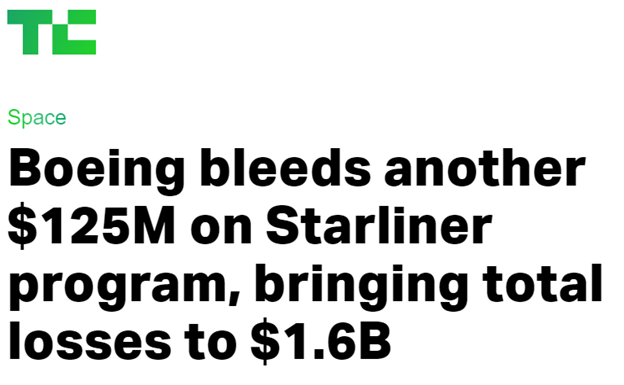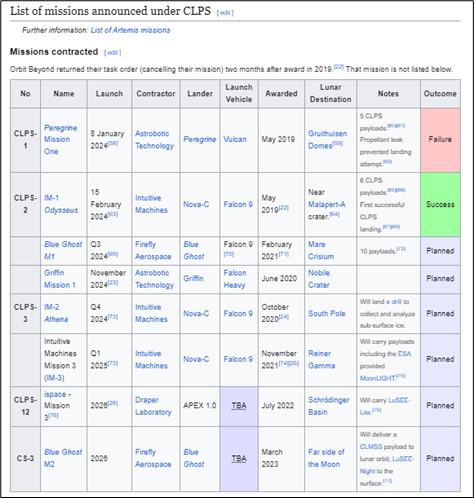 |
| By Karen Riccio |
Astronaut Neil Armstrong took “one small step for man and one giant leap for mankind” in 1969 when he became the first person to walk on the moon.
But over the past few weeks, NASA stumbled a bit as it works to re-establish the U.S. as the space race leader and stake America’s claim to the moon’s resources.
And I see those missteps resulting in out-of-this-world windfalls for the slew of private companies working on solutions in this space.
Here’s why.
As we speak, two astronauts (Barry "Butch" Wilmore and Sunita Williams) remain “stranded” in the first crewed voyage of the Boeing (BA)-made Starliner to the International Space Station. Boeing is just one of NASA’s many commercial partners.
The planned week-long mission is now on its ninth week due to a helium leak in Starliner’s propulsion system and malfunctions of five thrusters as it docked with the space station.
Although both deny that the astronauts are “stranded,” it’s a public relations nightmare for NASA and Boeing — especially the latter. The aerospace giant is already facing scrutiny due to safety and equipment issues with some of its planes.
Boeing had to overcome multiple Starliner problems over the years. The company launched an empty Starliner twice before committing to a crew, repeating the initial flight test because of bad software and other issues.

The delays cost the company more than $1.6 billion.
And public confidence in Boeing is falling faster than the markets did last Monday.
A Wall Street Journal article states Boeing and NASA are in a “tussle” over the plan to bring the astronauts home.
If accurate, this could get very ugly.
Apparently, as the WSJ suggested, the fact that NASA is “working on backup plans that depend on Elon Musk’s SpaceX, means that some experts think it’s not safe to rely on Boeing and instead change the Crew 9’s mission.”
Instead of what was planned, SpaceX's Dragon capsule could fly to space with two empty seats and carry space suits so Williams and Wilmore can return home.
If that turns out to be the solution they use, NASA says the two may not return to Earth until early 2025.
Internal conflicts do nothing to solve the immediate problem or instill confidence in NASA’s ability to steer the spaceship.
The next misstep by NASA is the last-minute cancelation of its $450 million VIPER robotic lunar rover mission. Budgetary restraints and supply chain issues stopped it dead in its tracks.
Set to blast off as soon as November, it would’ve explored the region near the moon’s South Pole to locate water and study the formation of ice there.
If found, the next step would’ve been to convert it to drinking water for astronauts or even rocket fuel, a boost to NASA’s plans to establish a permanent lunar position under its Artemis program.
But the best laid plans … you know the phrase.
The cancellation had nothing to do with the Griffin Lander, a platform built by privately held Astrobotic Technology.
NASA needed it to deliver the rover safely to the moon and sunk $323 million into the building of Griffin.
It’s important to note that Astrobotic’s contribution was made possible by another government program called commercial lunar payload service, or CLPS. So, the budget didn’t impact this key part of the mission.
CLPS is a series of public private partnerships formed to help fill in the hardware gaps and enable NASA to focus on scientific exploration of the moon. These partners allow for passing off the launch architecture to commercial companies.
So far, so good. NASA says that pretty much everything architected by SpaceX and Rocket Lab (RKLB) has proven to be strong assets.
However, the agency is always looking for more partners. The last time it reached out for bids on individual products, it selected 14 companies to be a part of CLPS.
The chart below shows some examples of current contracts.

I think both of these recent events open the doors even wider for private companies in all corners of the space race.
Future partnership opportunities with NASA abound — this as the government shifts its focus to private-sector innovation.
However, the biggest opportunities for young companies may come by making names for themselves.
Showcasing unique solutions for infrastructure technology, satellites (including launches and in-space repairs), cleaning up space debris, even exploring what’s needed to live outside planet Earth will be their biggest claims to fame.
This “New Space” technologies global market, as it’s being touted, is forecast by Space Capital to be worth around $1.1 trillion by 2030, for an annual growth rate of approximately 11%.
Now, you may prefer to take the more mainstream, diversified route to profit from the sector with the ARK Space Exploration & Innovation ETF (ARKX) or the Direxion Moonshot Innovators ETF (MOON).
However, I can’t think of a better longer-term investment than private equity right now considering the instability in the stock market.
I happen to know about the best one too!
Chris Graebe, your true startup and private equity guru, just wrapped up a trip to Cape Canaveral to check out this startup himself. What he found was even bigger than he initially thought.
This startup’s technology could spark a $1.8 trillion tech disruption … taking on SpaceX and others listed above.
In fact, he’s preparing a presentation that will go live at 2 p.m. Eastern today. You can catch it here.
Until next time,
Karen Riccio

